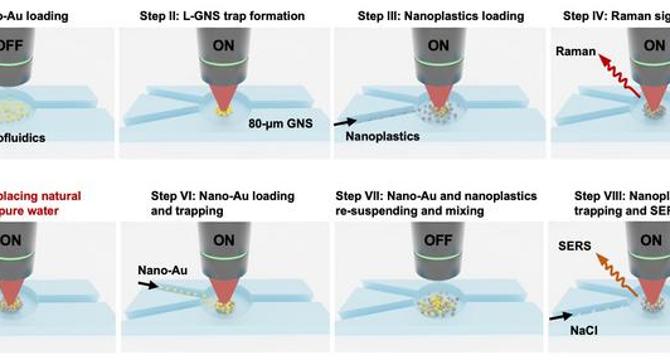Bioengineer
1d
107

Image Credit: Bioengineer
Assessing the Dangers of Nanoplastics: A Revolutionary New Tool Unveiled
- The rise of nanoplastics poses a significant environmental and health hazard, surpassing the existing concerns over microplastics, with their minuscule size and potential toxicity.
- A groundbreaking tool, the OM-SERS setup, has been developed by a team of international scientists from the University of Massachusetts Amherst to precisely quantify and identify nanoplastics in various complex samples.
- Plastics, due to their longevity, break down into micro-sized particles over time, dispersing throughout ecosystems globally, including remote regions such as Mount Everest and the Mariana Trench.
- The fragmentation of microplastics into nanoplastics poses a dire threat, with the potential generation of massive quantities of these hazardous particles that infiltrate air, water, and soil.
- Nanoplastics' unique characteristics, including high reactivity and permeability, raise concerns for environmental and human health risks, necessitating the development of effective detection methods.
- The innovative OM-SERS technique combines optical manipulation and surface-enhanced Raman scattering to offer swift and precise analysis of nanoplastic concentrations, making it a promising tool for identifying and quantifying nanoplastics.
- The versatility of the OM-SERS system extends beyond water samples, offering potential applications in diverse matrices like soils, plant tissues, and human biological samples after necessary preparatory steps.
- The collaborative efforts of scientists in addressing nanoplastic pollution signify a crucial advancement in environmental science, leading to a better understanding of hazards and driving initiatives for mitigation and regulation.
- The groundbreaking research using OM-SERS highlights the intersection of innovation and environmental stewardship, offering hope for combating plastic pollution through advanced detection and analysis methods.
- The study's implications reverberate in the realms of toxicology and policy-making, urging collective action and technological innovations to confront the looming crisis of plastic pollution.
- By leveraging scientific advancements like the OM-SERS technique and fostering interdisciplinary collaborations, the battle against plastic pollution gains momentum, paving the way for sustainable solutions in environmental conservation.
Read Full Article
6 Likes
For uninterrupted reading, download the app